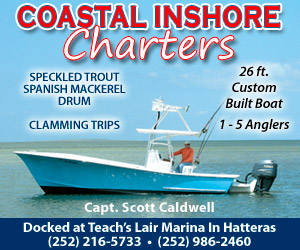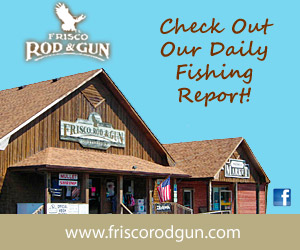In many cases, the fish in our waters are a lot like the people — they’re just not generally ready for extreme cold weather.
Frozen shallows and rapid drops in water temps can stun a variety of fish. Speckled trout, puppy drum, flounder and stripers, to name a few, can be highly susceptible to cold stun or death from these conditions.
We had a couple days of Arctic cold right after the first of the year, but, for now, there hasn’t been much in the way of chatter pertaining to cold-stunned fish.
I hope that this past storm is not what is in store for us this winter, as it will have adverse effects for recreational and commercial fishermen.
But, on a brighter note, we have seen the area come alive under these circumstances in the past, when puppy drum race out of the frigid sound, looking for warmer water in the ocean. In doing so, the semi-hibernating fish need to eat to compensate for the energy they have expelled. This has led to some epic surf bites in the dead of winter.
With that said, there has been some underground word of puppy drum around Frisco and other areas. Overall, though, it’s winter, and the inshore bite is going to be slow and inconsistent at best.
Offshore anglers have seen some decent yellowfin and blackfin tuna bites, with some boats limiting out. There have been a few bluefin tuna reported much farther south of us.
As usual, I’m looking forward to a new year and the fishing that it holds. I am also curious to see what the 2017 cobia regulations have in store for us.
In 2016, an unprecedented moratorium was imposed on these fish. It left mid-Atlantic states scrambling to either join or abandon the proposed rule that prevented the harvest of cobia beyond the 3-mile mark where state waters end and federal waters begin. It led to many changes in the recreational and charter harvest of these fish within state waters.
The theory of fisheries managers is that cobia are being overfished — or close to it.
The 2016 North Carolina regs looked like this:
Many argued these rules were not necessary to protect the stock that was said to be in danger of being overfished and that some lackluster data said had already happened.
About 98 percent of cobia are caught sight-casting for them, while they’re swimming on the surface. And, while this is a major draw for anglers to test their skill at seeing and throwing lures at them, it also helps preserve the stock, as it’s not as easy as you might think.
Also, weather plays a huge factor in how these fish are caught in our waters, as they do end up being pushed offshore in big numbers some seasons, limiting how they are harvested.
Actually, these fish are great at self-managing.
Whether an angler is good or bad at catching cobia is neither here, nor there—the fish are a decent economic draw.
Putting these types of restrictions on this fish is another blow to coastal communities that rely on a variety of fish to help drive their economies. Recreational and commercial fishing pay the bills for many a person around here.
That might include the captain, the mate, the employees at a marina or tackle shop, or the people packing fish at a fish house.
It even stretches down to a guy like, Billy Gorham, who owns and operates a small business called Bowed Up Lures that makes and sells a variety of fishing lures and one of his top sellers is for targeting cobia.
Billy loves to cobia fish, along with making lures, and he has taken it upon himself to stay informed about what is going on and has attended almost every meeting pertaining to the proposed 2017 regulations. He has passionately argued in favor of more lenient regulations pertaining to cobia.
The man truly knows more about this subject than most anyone, including those trying to change the rules – at least in my opinion.
The South Atlantic Fisheries Management Council(SAFMC) and NOAA lead the way in trying to continue the moratorium in federal waters, along with bag limits and time frames in North Carolina state waters.
No true angler, recreational or professional, wants to be responsible for damaging any stock. However, the data that is used to come up with suggested take each year is beyond flawed, and there is no real way to determine the health of the stock.
Furthermore, Florida and the Gulf States are unaffected by this rule. They continue to have an open season for cobia year-round. These states are known for high catches, and it’s also known that some cobia in our waters do make it to Florida in the migration patterns.
I asked Billy recently what he would like to see in 2017 if there are more rules imposed on cobia again this year. He is adamant that there is no rule necessary, but said he’d like to see a less restrictive season.
Billy and everyone else would like to see the “no cobia over 3 miles” moratorium lifted.
Inshore, Billy would like to see something like this for 2017.
Billy emphasizes that none of this is necessary. That the previous state rule of two fish, per person, per day with a season open year-round was just fine.
If any of you ever have the opportunity to talk to Billy or hear him speak on the subject, you will realize just how much he knows about the subject and the data.
This is going to be one hot topic as spring approaches. These fish help to get the inshore economy moving, along with the red drum and other species. If you have witnessed all the charter boats gone from the area marinas or all the trucks and trailers at area launch sites, then you understand the economic value of these fish up and down the seaboard.
Protecting the stock is in everyone’s best interest, but over-protection will have negative effects on many.
I personally hope that those who make the policy will show some good sense and spare our coastal community from more unnecessary restrictions.
Time will tell the tale.
I hope each of you had a great start to your new year.
While I believe the offshore fishing is prime, I do know inshore and surf fishing will be more hit or miss—it’s winter. Nevertheless, that doesn’t mean you can’t come down and pay a visit for the weekend or a few days and give it a try.
You can’t catch fish sitting at home, and it’s got to be better than working.
Go fish and play hard.
(Rob Alderman has lived on the Outer Banks for more than 16 years and has worked in the recreational fishing industry the entire time. A former variety fishing TV show host, beach fishing guide, tackle shop and pier employee, Rob currently owns and operates Outer Banks Kayak Fishing. He is on the Pro-Staff of Bending Branches LLC, Wilderness Systems Kayaks, Release Reels, Yakattack and is an ambassador for Ugly Stik. You can follow his adventures at www.FishMilitia.com or OuterBanksKayakFishing.com.)





